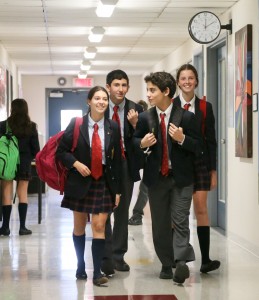 Over the past several years I have been struck by how few young women – or young men for that matter –feel true affinity to the “F” word. I am not thinking about our teens’ tendency to use foul language. Rather, I’m thinking about a term that seems to have become almost dead, but certainly outdated amongst the young: the word “feminist.” In the past several years in the classroom and at student leadership conferences, young women 14–18 years old have been frank with me on this topic. They’re not feminists; they contend that’s just for radicals. Today’s teens see gender equity as a given, as part of the new normal their mothers and grandmothers fought for on their behalf.
Over the past several years I have been struck by how few young women – or young men for that matter –feel true affinity to the “F” word. I am not thinking about our teens’ tendency to use foul language. Rather, I’m thinking about a term that seems to have become almost dead, but certainly outdated amongst the young: the word “feminist.” In the past several years in the classroom and at student leadership conferences, young women 14–18 years old have been frank with me on this topic. They’re not feminists; they contend that’s just for radicals. Today’s teens see gender equity as a given, as part of the new normal their mothers and grandmothers fought for on their behalf.
I bring this up because this past week marked the 50th anniversary of a pivotal book in the feminist movement. The Feminine Mystique was written in 1963 by American, Betty Friedan. It was a lightning rod for frustrated wives and mothers and was an inspiration to a whole generation of feminists who were proud to wear that label. The 50th anniversary has sparked interesting articles in the mainstream media and much discussion.
Reading and listening to some of this discussion in recent days made me think about LCC students today. Only 20 years ago our school was available only to boys, and in my view, becoming coed in the mid 1990s was a brilliant decision. I speak to alumni and community groups all the time and remind them that many independent schools in Montreal remain single sex. I believe adopting a coed learning environment simply helped to make LCC a more progressive and improved school. Although our students probably rarely think about it, a coed environment is a powerful learning platform. It’s a key part of their daily curriculum –the sharing of ideas, perspectives – the capacity for girls and boys to collaborate, debate, agree, disagree and learn together shoulder to shoulder. It’s a real world experience, part of what I refer to with alumni and parents as the “coed advantage.”
Let me back up for a moment and present you with the Webster dictionary’s definition of the word “feminist.” It is defined as “the theory of political, economic and social equality of the sexes – with a focus on organized activity on behalf of women’s rights and interests.”
From a historical point of view, some of us could name a couple of so-called “first wave” of Canadian feminists like Nelly McClung and Emily Murphy who around 1915 worked at gaining women the right to vote and hold public office.
American women such as Betty Friedan and Gloria Steinham were part of the so-called “second wave” of feminists who concentrated on women’s reproductive rights and parity in the workplace in the 1960’s and beyond. And here we are today where teenagers regardless of gender generally believe that gender equity has been achieved. No need for feminists. Perhaps that’s a good thing.
However, I thought I would check some facts. Is gender equity really such a slam-dunk? Is gender equity actually a practical reality across modern Canada? I consulted recent Statistics Canada & Status of Women Canada documents and discovered some interesting data:
Education & Employment:
- Women at post-secondary institutions in Canada are dominating. They represent 56% of all registered students and represent almost 60% of graduates
- Among all Canadian 25-34 year olds, 26% of men hold a Bachelors degree or higher, while 34% of women hold a Bachelor degree or higher (a notable 8% difference). But note only 15% of women held degrees in 1990. This has more than doubled in 22 years.
- In the workplace, about 9 million women are employed – more than double the number in 1976. Two-thirds are still in traditional female occupation: nursing, teaching, health, clerical, sales or services.
- 73% of women with children are employed vs. only 39% in 1976 – a huge societal shift.
- But despite these notable changes, women still only earn 83% of every dollar earned by a man, but that’s been on the rise for the past 20 years when it was only 75 cents.
One of the ongoing challenges for men and women in a world where there is more equity and opportunity in the workforce is the status of the family. Clearly, the balancing act of work and family is challenging for all. Census and research data show some interesting trends here as well:
- Women are having fewer children in Canada and later in life. In the 1960’s the average woman had her first child at 23, now it’s at 30 years old. That same woman was likely to have four children, now it’s less than two on average.
- There are now more single parents than ever, but four times as many are households headed by women than men: 1.1 million vs. 280-thousand men in 2010.
- In addition to full-time work, women still seem to take on the greatest burden of rearing children: more than twice as many hours a week (51) than men (24). The same trend applies to housework and caring for aging parents. Women still account for twice as much effort in those domains, despite working full time.
Another category that warrants mention is the dark reality of family violence and spousal abuse. It’s a fact of life that needs our attention. Yes, it is a gender issue as in almost 100 % of the cases, women are victims. Unfortunately, the number of women’s shelters in Canada has grown since 2000 (now 600). On any given day, they house about 5,000 women, with one-third (1/3) as repeat visitors. This sad state of affairs is everyone’s problem.
A week ago a new premier was named in Ontario, making 6 of our 10 provincial leaders women, including the Premier of Québec, Pauline Marois. This is an interesting trend given that only 25 % of all members of our federal parliament are women, ranking us as 16th in the world.
So what does this all mean? In short, gender issues are complicated. I certainly believe that we have moved toward greater gender equity in recent years. However, the topic of gender roles is messy and rarely obvious.
I’m a feminist. But maybe today that’s an odd generational statement by a man or woman. I don’t think teenagers need to label themselves as feminists. However, our students have the benefit of being in a coed school preparing for the realities of life in a coed world. I think they owe themselves the opportunity to investigate and discuss some of the topics and issues I’ve outlined here. They’re important and sometimes difficult. Ultimately, I hope that where it matters most, LCC students and LCC grads will do what it takes to defend gender equity and social justice where it matters most. —Chris Shannon, Headmaster
 So what is the coed advantage? It’s everywhere at LCC, but it was certainly on display this morning at our Middle and Senior School assembly. A group of girls and boys collaborated to lead several presentations on the sensitive topic of feminism and gender issues. It was exactly the kind of activity that underscores the benefits of having girls and boys together in a constructive learning environment.
So what is the coed advantage? It’s everywhere at LCC, but it was certainly on display this morning at our Middle and Senior School assembly. A group of girls and boys collaborated to lead several presentations on the sensitive topic of feminism and gender issues. It was exactly the kind of activity that underscores the benefits of having girls and boys together in a constructive learning environment.


